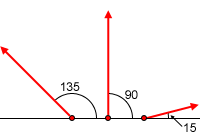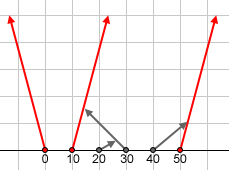Problem Statement

Sometimes, two or more roads intersect at some point. When this happens, the car that reaches the intersection first is able to block the intersection so that no other cars can pass through it. If two cars arrive at an intersection at the same time, the car that appears earlier in the input (lower index) will be the only car to pass through.

In this picture, the cars following the red paths at 0, 10 and 50 pass all intersections, while the cars following the gray paths are stopped (see example 0).
You will be given two int[]s, positions, and angles, where the ith car corresponds to the ith element of positions and the ith element of angles. The ith element of positions is the x coordinate of the ith car. The ith element of angles is the angle in degrees between the x-axis and the road that the ith car travels on. Your method should return a int[] containing the 0-based indices of all the cars that will pass all the intersections along their roads. Your return should be sorted in ascending order.
Definition
| Class: | Crossings |
| Method: | getOut |
| Parameters: | int[], int[] |
| Returns: | int[] |
| Method signature: | int[] getOut(int[] positions, int[] angles) |
| (be sure your method is public) | |
Constraints
Examples
| ||
Returns: { 0, 3, 5 } | ||
| ||
| ||
Returns: { 0, 1 } | ||
| ||
Returns: { 0 } | ||